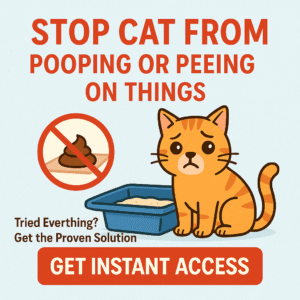Watching your cat feel under the weather can be heartbreaking. You want to help—but what should you feed them when they’re sick? This guide delivers five vet-approved homemade recipes tailored for recovery, easy digestion, and comfort. You’ll learn meal prep, nutrition insights, and recovery strategies—all while discovering how the Cat Spray No More ebook gives you structured feeding logs, hydration trackers, and calm routines to support your cat’s healing journey.
Introduction
When cats are ill—whether recovering from surgery, fighting infections, or dealing with gastrointestinal upset—a soft, nourishing, easy-to-digest diet can make recovery faster and smoother. These five homemade foods are crafted to be gentle on the tummy, rich in protein, and hydrating. You’ll also find guidance on soothing presentation, portioning, and when to consult your vet.
Why Homemade Meals Help Sick Cats
- Gentle digestion: Soft textures avoid straining upset stomachs.
- Hydration: Including broths helps maintain fluid intake.
- High-quality protein: Supports tissue repair and immune function.
- No additives or fillers: Reduces the risk of reactions or diarrhea.
- Appetite stimulation: Fresh, warm foods often entice cats who refuse kibble.
Recipe 1: Chicken & Rice Recovery Mash
Classic comfort food that’s easy to make and digest.
Ingredients
- 3 oz cooked chicken breast, shredded
- 2 tbsp cooked white rice
- 3–4 tbsp low-sodium chicken broth (warm)
- Optional: dab of plain pumpkin puree
Instructions
- Combine chicken and rice.
- Add warm broth and pumpkin, mix until mash.
- Serve lukewarm in small spoonfuls.
Why It Works
- Rice soothes digestive upset.
- Chicken delivers lean protein.
- Broth encourages drinking and comfort.
Recipe 2: Turkey & Pumpkin Puree
High-fiber, protein-rich puree for digestive recovery.
Ingredients
- 4 oz ground turkey, cooked and drained
- 2 tbsp pure pumpkin (no additives)
- 2 tbsp warm water or broth
Instructions
- Mix turkey with pumpkin.
- Add liquid to form a thick puree.
- Serve at room temperature.
Why It Helps
- Pumpkin adds fiber, easing either diarrhea or constipation.
- Turkey is lean and digestible.
Recipe 3: Salmon & Sweet Potato Blend
Omega-3 rich meal that supports inflammation and appetite.
Ingredients
- 2–3 oz cooked salmon, flaked
- 2 tbsp cooked sweet potato
- 1–2 tbsp low-sodium broth
- 1 tsp olive oil
Instructions
- Mix salmon and sweet potato.
- Add broth and olive oil, stir into a moist blend.
- Serve lukewarm.
Why It Helps
- Omega-3s reduce inflammation and support recovery.
- Salmon protein is easy to eat and digest.
- Sweet potatoes provide gentle fiber.
Recipe 4: White Fish & Zucchini Puree
Delicate and low-fat meal ideal for sensitive stomachs.
Ingredients
- 3 oz cooked white fish (e.g., cod), flaked
- 2 tbsp steamed zucchini, mashed
- 2 tbsp warm broth
Instructions
- Combine fish and zucchini.
- Add broth until lappable.
- Serve warm.
Why It Helps
- White fish is low in fat and easy to digest.
- Zucchini adds moisture and light fiber.
Recipe 5: Beef & Cauliflower Comfort Bowl
Rich protein and gentle fiber for rebuilding strength.
Ingredients
- 3–4 oz lean ground beef, cooked and drained
- 2 tbsp mashed cauliflower
- 2 tbsp warm broth
Instructions
- Combine beef and cauliflower.
- Add broth, mash lightly.
- Serve at room temperature.
Why It Works
- High-quality protein helps recovery.
- Cauliflower supports gentle digestion with fiber.
Feeding Guidelines & Storage
- Make fresh each day; refrigerate leftovers up to 24 hours in sealed containers.
- Reheat gently to room temperature; label with date.
- Serve in small portions—one meal at a time to avoid waste or chocking.
- Include multiple fresh water bowls or a pet fountain to support hydration.
- Log meals, appetite, water intake, and stool in the Cat Spray No More feeding tracker.
When to Use These Meals
- Post-surgery recovery
- Gastrointestinal upset (e.g., vomiting/diarrhea)
- Appetite loss or difficulty eating kibble
- Low-energy or recovering from illness
Always transition slowly: Start with a teaspoon, then gradually increase to 1–2 meals per day, monitoring tolerance and bowel habits. Consult your veterinarian if symptoms persist.
Red Flags Requiring Vet Attention
| Symptom | When to Visit Vet |
|---|---|
| Ongoing vomiting or diarrhea over 24 hours | Seek veterinary care |
| Refusing all food for more than 24 hours | Immediate vet visit |
| Blood in vomit or stool | Emergency vet care |
| Signs of dehydration (sunken eyes, dry gums) | Emergency veterinary attention |
How Cat Spray No More Supports Recovery
- Feeding & hydration logs: Track every meal and water intake.
- Appetite tracking: Note eagerness, portions eaten, leftovers.
- Medication reminders: Record pain or antibiotic doses alongside meals.
- Stress-free feeding routines: Ebook includes calm dining setups for sick cats.
- Vet-prep form: Ready-to-share logs during follow-ups.
Real Cat Recovery Story
“After surgery, Luna wouldn’t eat her regular food. I made the chicken-rice mash and gave it slowly. With the feeding tracker in Cat Spray No More, I saw her appetite return by day three. She bounced back faster than I expected.”
Conclusion
Feeding sick cats doesn’t have to be stressful or complicated. These five homemade meals provide the nourishment, hydration, and gentle comfort they need during hard times. With careful portioning and vet guidance, you can support recovery with confidence. And with the structure, tracking, and care logs in the Cat Spray No More ebook, you’ll have the peace of mind that every meal and hydration moment contributes to health.
Ready to take charge of your cat’s recovery? Download your copy of Cat Spray No More now—for feeding logs, hydration trackers, medication schedules, and stress‑free care routines that help your sick cat feel their best again.
